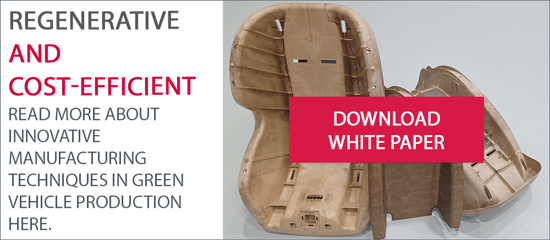As part of a research project, EDAG Engineering and the Fraunhofer IMWS have joined forces with other partners at to create a child seat made from bio-based and natural fiber-reinforced plastics (bio-NFRP). The aim of this project is to develop sustainable lightweight components that can be manufactured economically in series production of vehicles.
The requirements for vehicle parts are changing rapidly, especially with regard to electromobility and urban mobility. Today, vehicle parts must not only be functional, but also sustainable. The solution lies in the combination of materials that have been developed for specific applications.
This is where the multi-material structure comes into play, which is not only functional but also economical. Biopolymers and natural fibers offer new possibilities for applications that were traditionally reserved for glass or carbon fibers in terms of strength and functionality, but can significantly reduce the CO2 footprint.
Accordingly, the importance of natural-based materials in component development is also growing in the automotive sector, as they enable resource-saving and recyclable products. The "RegScha" ("Regenerative Seat Shell") research project focused on the innovative combination of bio-based and natural fiber-reinforced plastics, which were to be used in a hybrid and recycling-oriented product design for high-performance products, such as seat structures in vehicle construction.
Materials and technologies
The state of the art in fiber-reinforced thermoplastics is dominated by glass fiber composites. Organic sheets, primarily consisting of glass fiber-reinforced polypropylene or polyamides, are widely used in the aviation and automotive industries. Natural fiber-reinforced plastics (NFRP), on the other hand, are mainly used in vehicle interiors, where their light weight, ecological compatibility and cost efficiency make them a convincing choice. Nevertheless, the strength and rigidity of bio-based and natural fiber-reinforced plastics must be further improved so that they can conquer other technical fields of application.
As part of the research work, special bio-NFRP-UD tapes were developed that consist of flax fibers and bio-based polyamides. These materials are characterized in particular by their specific stiffness and are competitive with conventional GRP semi-finished products, i.e. those made from glass-fibre reinforced plastics. However, natural fiber semi-finished products are more expensive than conventional materials due to the fact that manufacturing technologies are not yet fully developed, and quality fluctuations are also higher.
Design and production
One of the greatest challenges in the development of components made of bio-NFRP is the optimization of the design principles. As part of the project, a design was developed for the seat shell of a child seat that is both functional and aesthetically pleasing. The design was based on an iterative collaboration between the project partners, whereby the geometry and choice of materials were specifically tailored to the requirements of production and use. The child seat had to be light yet rigid enough to meet the necessary safety standards.
A commercially available child seat served as a reference for the structural design. The load paths were determined by topology optimization and the material data for the bio-NFRP insert and the wood fibre-modified bioplastic were integrated on this basis. A variant analysis revealed that a combination of eight layers of UD tapes and a specific fiber orientation offered the optimum ratio of stiffness and weight.
 Mechanical properties of the tested bio-NFRP made from bio-based polyamides and flax fibers (© Fraunhofer IMWS)
Mechanical properties of the tested bio-NFRP made from bio-based polyamides and flax fibers (© Fraunhofer IMWS)
Innovative hybrid injection molding
The combination of thermoplastics and natural fibers offers great advantages in terms of recyclability, automation and integration of functional elements. Thanks to the hybrid process combination of thermoforming and injection molding, bio-NFRP materials can be processed efficiently. Bio-NFRP inserts were used for the production of the child seat, which were transferred to the injection mold by a robot and further processed there.
The specially developed robot gripper concept enabled precise handling of the inserts both when cold and when melted. With this approach, a hybrid manufactured child seat demonstrator could be realized, which consists of bio-NFRP injection molding material and bio-NFRP UD tapes.
 Child seat demonstrators made from bio-NFRP injection-molded material and bio-NFRP tape laminates using hybrid injection molding (© Fraunhofer IMWS)
Child seat demonstrators made from bio-NFRP injection-molded material and bio-NFRP tape laminates using hybrid injection molding (© Fraunhofer IMWS)
Conclusion
The research results clearly show that a combination of bio-NFRP and metal has the potential to produce sustainable and resource-saving lightweight components. The concept of the "bio-hybrid" will therefore be investigated further in future work. The aim is to develop a child seat that combines a metal insert with bio-NFRP materials. This approach promises a better eco-balance and significantly greater sustainability than conventional components.
Do you also have plans for sustainable assemblies in lightweight construction or would you like to find out about possible applications in this area? Then talk to our expert Dipl.-Ing. Michael Begert, Innovation Manager at EDAG Engineering. Or download the white paper "Economical lightweight construction with bioplastics and natural fibers" right here. It provides you with detailed insights into the material development, the manufacturing process and the structural challenges of this lightweight construction project. 





